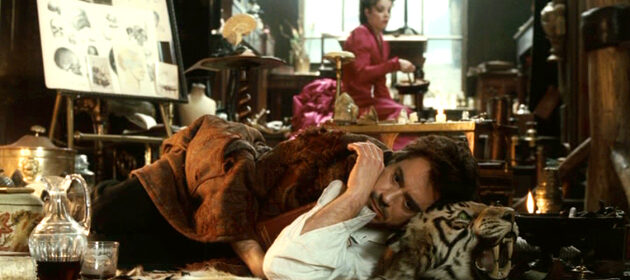Sarah Greenwood

So you know we’ll see what comes in. I quite like small budgets as well. I’m reading another script at the moment which is very low budget. It’s set in one house and I was saying, What could be nicer? Rather than doing these massive, multiple-location, very difficult films and you think, Actually, wouldn’t it be nice to do a film that was just set in one place?
AS: How closely do you work with the DP?
SG: Very closely. You do as much as you can and it’s almost like handing over your baby when it’s done. They just make it better and better. And the way they use space, I love the way things come to life. Both Seamus McGarvey and Philippe Rousselot, they appear to be very effortless in the way that they light. It just happens, which is just fantastic. It doesn’t appear to be a struggle to achieve what they achieve. Seamus in particular works so closely with Joe and he’s so bright, and clever and articulate. That’s another layer when you’re talking about characterization and feel and atmosphere. They’re great. They’re the third part of the triangle.
AS: How do you feel about the future of production design and moviemaking? There seem to be more and more green-screens and visual effects. How do you think that will affect what you do?
SG: Well, personally I’m glad I’m doing it at the time I’m doing it because I think it might go further that way. I don’t know that I’d be interested in doing any more green-screen than I am doing. It’s almost too much what I have been doing! I think that there’s going to be horses for courses, really. I think there’s a place for all sorts of movie-making. The bottom line for me is good scripts. But I do think it’s very important that we embrace the whole digital side of things and that we are involved in post production.
The concept that when it’s done in post, in the CG world, that it doesn’t need designing, that’s just ignorance beyond belief. I think it’s great that films like Avatar and Alice in Wonderland have won because it just shows actually that these are production designed, these films. Whether it’s fair to put them against films that are made differently I don’t know. I don’t know whether that means there should be another category.
It’s important that you don’t have some techie in some basement doing the visualization of something. I’ve heard of directors saying, Give me a hundred versions of this. And that’s wrong to my mind. They’re not the right people to be doing it. If you want it designed, then get it designed. It’ll be interesting to see how it pans out. It’s a good time to be working in the industry.
AS: Have you always wanted to be involved in films or is it just something you fell into through the theater?
SG: I wouldn’t say that I set out to be a production designer, no. When I started out I didn’t know that you could go and study theater design. I went from theater to television because the creativity in theater was not what it could be and I thought, Well, if it’s not overly creative then I might as well go to television and make loads of money and not be overly creative. TV is amazing -I just love the speed with which you turn things around. In theater you spend three months designing and building one set that’s on stage for three months. Whereas in film and TV you might have six weeks to design ten sets and get them in and out. It was like a total revelation. A completely different approach to designing.
AS: One thing I noticed in the first Sherlock Holmes was how many sets there were!
SG: There are even more in Sherlock 2! It’s just absolutely crazy. The mad things that you get to design! It’s a good game to be in. I love it, really.
Pingback: Laurence Bennett